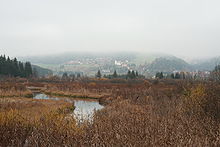Hörfeld (Austria)

The Hörfeld is a moor at the beginning of the Görtschitztal on both sides of the Styrian-Carinthian border. The moor is about 140 hectares, 3 km long and 500 m wide and two thirds of it is in Carinthia. It is home to 500 species of butterflies, 125 species of birds and over 50 rare plants.
The moor was created in a trough formed by glacial grinding and the peat layer is up to 8 m thick. It is fed by the Hörfeldbach and the Fallgrabenbach. There are extensive reeds in which some sea eyes are exposed. At the edge of the reeds there are meadows of pipe grass, sedges, willow bushes and gray alder. Some places indicate a transition to the raised bog . There are also numerous goblet pots as a special feature - water holes up to three meters wide and eight meters deep, which are fed by underground springs.
Special features of the flora are the very rare shrub birch ( Betula humilis ), the tongue buttercup ( Ranunculus lingua ) and the dock ( Rumex aquaticus ). The alpine pondweed ( Potamogeton alpinus ) occurs in the reservoir area of the runoff. The moor is rich in amphibians and reptiles and is an important resting place for migratory birds.
Nature reserve
The Hörfeld is a nature reserve in both countries : The Styrian nature reserve is located in the municipality of Mühlen , was established in 1987 and is 5.8 hectares in size. The Carinthian nature reserve is located in the market town of Hüttenberg , was established in 1984 (LGBl. No. 37/1984) and is 96.8 hectares in size.
supporting documents
- Helmut Hartl, Hans Sampl, Ralf Unkart: Carinthia's gems. National parks, nature reserves, landscape reserves, natural monuments . Kärntner Druck- und Verlagsgesellschaft, Klagenfurt 1993, ISBN 3-85391-092-0 , p. 162.
Individual evidence
- ↑ NSG 04b Hörfeld , accessed on July 27, 2016.
Coordinates: 47 ° 0 ′ 51 ″ N , 14 ° 30 ′ 46 ″ E